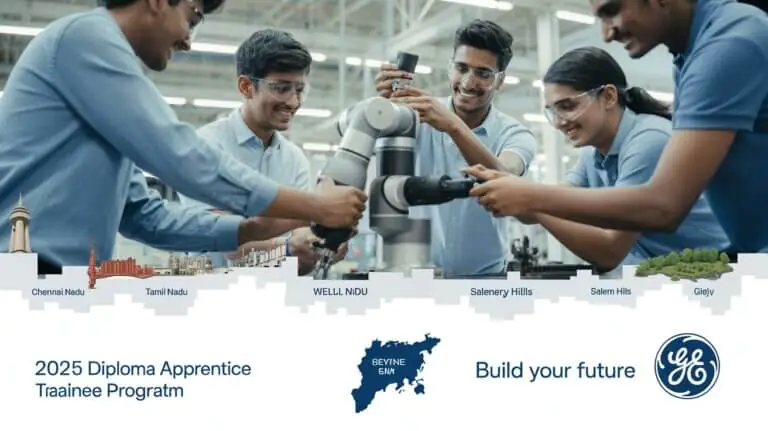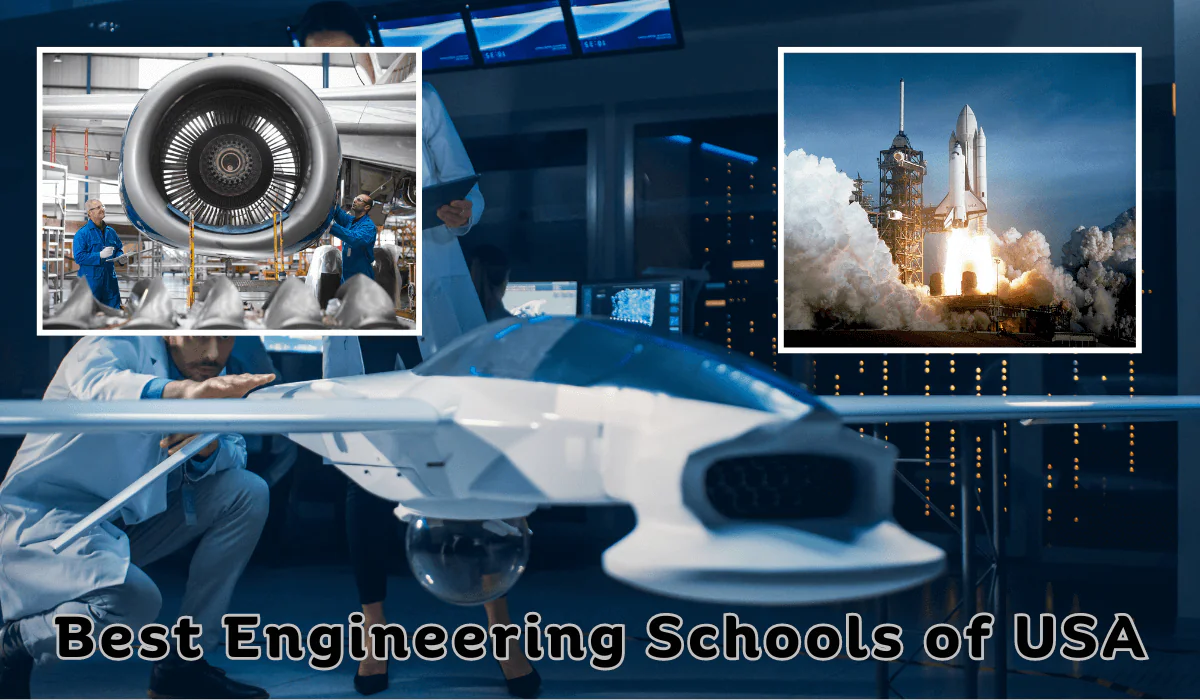
Are you passionate about aircraft, spacecraft, and everything related to the skies above? Pursuing a career in aerospace engineering might be your calling. But with so many colleges offering this specialized program, how do you choose the right one for you? so let’s dig out list of the Best Aerospace Engineering Schools.
Aerospace engineering is one of the most advanced and specialized fields in engineering, focusing on the development and design of aircraft, spacecraft, satellites, and missiles. With a growing interest in space exploration and aviation, and many private entities increasing their investments in this sector, many students are exploring opportunities in this sector.
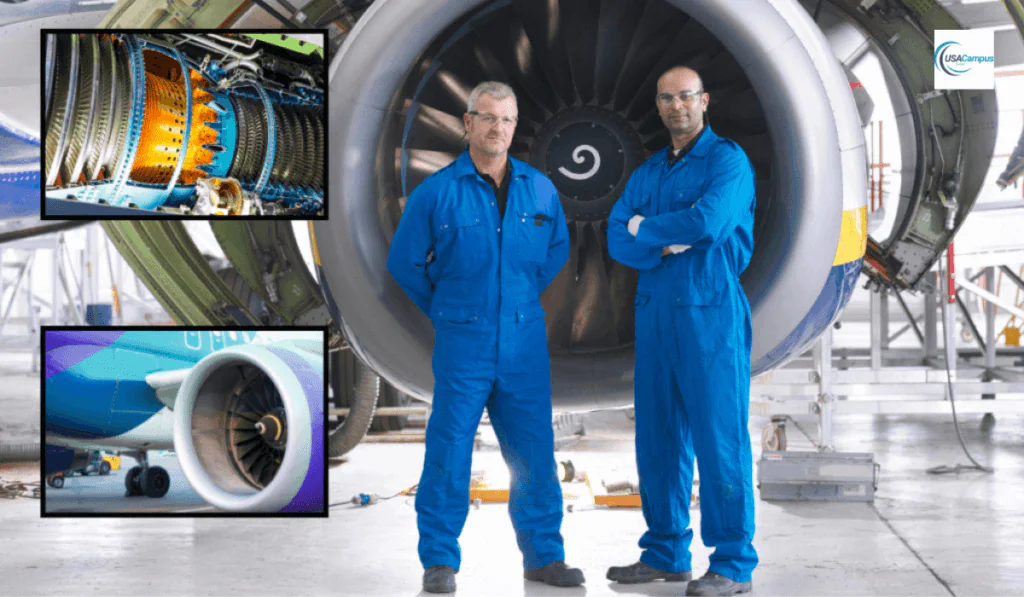
This comprehensive guide will provide you with essential information about aerospace engineering courses, eligibility criteria, of Best Aerospace Engineering Schools in the United States, their rankings, fee structures, unique selling points (USP), placement records, and future prospects for graduates.
What is Aerospace Engineering
Aerospace engineering is an intriguing discipline that integrates the fundamental principles of aerospace engineering math, physics and materials science to create and develop aircraft, spacecraft, satellites and missiles. The field encompasses the examination of aerodynamics, propulsion systems, flight mechanics, and structural design. Aerospace engineers have a vital role in the progress of technology for aviation and space exploration.
Students studying aerospace engineering acquire the skills to develop and implement inventive strategies to address intricate problems in the aerospace sector. They explore topics such as fluid dynamics, thermodynamics, control systems, and avionics. As technology progresses, the need for faster and more efficient aircraft and spacecraft increase.
Aerospace engineers lead the way in developing advanced technologies that push the limits of what is achievable in aviation. From developing environmentally-friendly aircraft with decreased carbon emissions to conducting exploration missions on Mars using robotic rovers,
Aerospace engineering presents boundless prospects for ingenuity and advancement. As students begin their pursuit of aerospace engineering, they acquire the necessary abilities to make significant contributions to revolutionary breakthroughs that influence the future of air and space transportation.
Scope for Aerospace Engineering
Aerospace engineering is a fascinating and diverse field that designs, develops, builds, tests, and operates vehicles for Earth and space. This field began in 1958 when flight vehicle development began to consider the Earth’s atmosphere and space above it.
There are two main aerospace engineering branches:
Aeronautical Engineering
Aeronautical engineering is a subset of aerospace engineering that specifically deals with the design and development of aircraft that fly within the Earth’s atmosphere.
Astronautical Engineering
This branch studies rockets, satellites, and spacecraft. Aerospace engineers must know aerodynamics, propulsion systems, structural design, materials science, avionics, and stability and control systems. Aerospace engineers choose materials, propulsion systems, and design aircraft and spacecraft.
Top Colleges for Aerospace Engineering
Choosing the right college is crucial as it can significantly impact your future career prospects. Consider factors like faculty expertise, research opportunities, industry connections, and campus culture when making your decision. Remember that each college has its unique strengths and offerings tailored to different student needs.
Whether you dream of designing next-generation aircraft or exploring outer space through innovative technologies, selecting the best college for aerospace engineering will set you on the path towards achieving your goals.
Eligibility Criteria
To enroll in an aerospace engineering program, students typically need to meet the following criteria:
- High School Diploma: Completion of high school with a strong foundation in mathematics and science.
- SAT/ACT Scores: Competitive scores on standardized tests such as the SAT or ACT.
- Letters of Recommendation: Strong recommendations from teachers or professionals.
- Personal Statement: A well-written essay highlighting the student’s interest in aerospace engineering.
- Extracurricular Activities: Participation in relevant student organizations or projects.
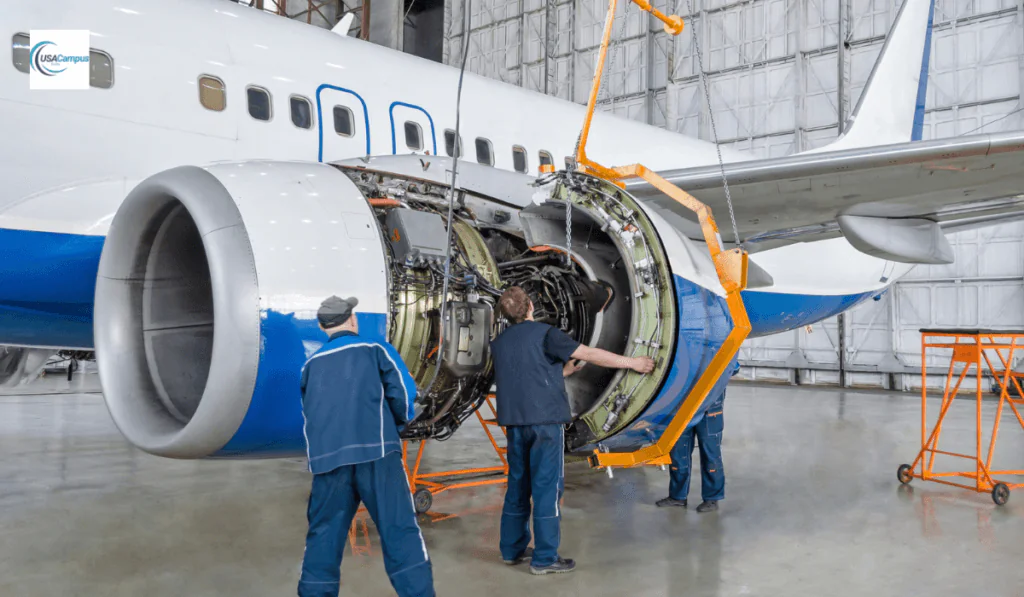
Top 10 Aerospace Engineering Colleges in the United States
- Massachusetts Institute of Technology (MIT)
- California Institute of Technology (Caltech)
- Stanford University
- University of Michigan, Ann Arbor
- University of California, Berkeley
- Georgia Institute of Technology
- University of Illinois, Urbana-Champaign
- University of Maryland, College Park
- University of Texas, Austin
- Purdue University, West Lafayette
- Ohio State University
- UC davis
Detailed insights into Top Colleges
Massachusetts Institute of Technology (MIT)
Aerospace programs at MIT are world-class. MIT offers a broad aerospace engineering curriculum in aerodynamics and propulsion. MIT students learn from world-class, expert faculty.
A highlight of MIT’s aerospace programs is hands-on experience. Students are given many research and design projects to apply their theoretical knowledge to real-world problems. These projects teach students problem-solving, critical thinking, and teamwork, which the aerospace industry values.
MIT students have access to cutting-edge wind tunnels, propulsion labs, and flight simulators. These advanced resources let students experiment and simulate aerospace concepts to gain practical experience.
Strong industry partnerships benefit MIT’s aerospace programs. The department partners with top aerospace companies to offer internships, co-ops, and industry-sponsored research. These partnerships expose students to real-world applications and industry practices to prepare them for aerospace industry challenges.
How can I get Admitted to MIT? | Exclusive Guide for Admission in MIT
Average annual cost : $53,790
USP
- MIT has world-class facilities, specialized courses, and research opportunities. like
- World-class research facilities, including wind tunnels and spacecraft simulators
- Strong emphasis on hands-on learning and design projects
- Opportunities to work on cutting-edge research with leading faculty
- Excellent industry connections and internship opportunities
California Institute of Technology (Caltech)
Caltech, or the California Institute of Technology, is well-known all over the globe for its excellent academic programs and innovative research. The Aerospace program is known for its exceptional opportunities for students to participate in innovative research and prepare for prestigious careers in aerospace engineering. It is one of the highly regarded departments at the university.
Academic rigor, world-class instructors, and cutting-edge facilities are hallmarks of Caltech’s Aerospace program. Students will acquire a thorough grounding in basic concepts and have ample opportunity to participate in practical research thanks to the program’s emphasis on both theoretical and practical learning.
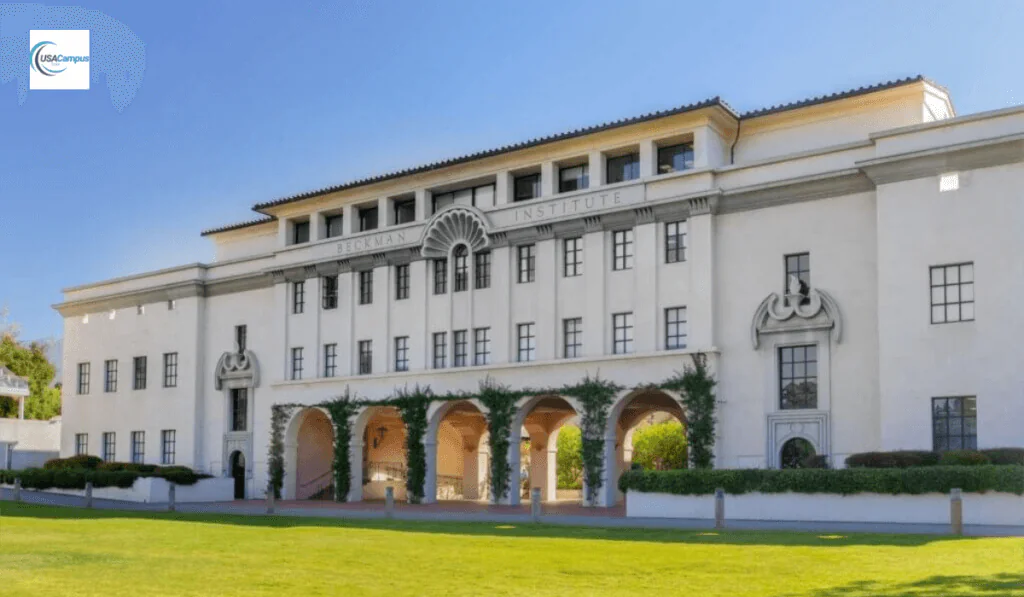
USP
- The integration of aeronautics and astronautics, with a strong emphasis on both theoretical and applied research, constitutes an interdisciplinary approach.
- Notable Professors: Distinguished academics with extensive experience teaching at the university level, including members of the National Academy of Engineering and Nobel laureates.
- Modern Resources: Use of state-of-the-art research facilities, such as the GALCIT combustion and wind tunnels.
Stanford University
Stanford university is always known for it iconic name, its culture & infrastructure. Their program always stand high because of their ties with Govt. and other agencies.
Stanford’s Department of Aeronautics and Astronautics offers highly comprehensive programs at both the undergraduate and graduate programs.
Financial Aid for International Students
USP
- The department boasts renowned faculty members who are experts in various aspects of aerospace engineering schools, including aircraft structures, computational fluid dynamics, space systems, and autonomous systems.
- Stanford has close relations with NASA-Ames Research Center, providing students access to extensive aeronautical research facilities and supercomputers
- Graduates from Stanford’s aerospace engineering programs are well-prepared for careers in aircraft and spacecraft engineering, space exploration, air and space-based telecommunication industries, and academia
University of Michigan, Ann Arbor
Right from beginning University of Michigan stood well in overall ranking, because of their unique program structure, their overall ranking, research facilities.
USP
- Because of it’s great history universities alumni always been found in many organization. which always put them in higher rank compared to others.
- Due to long history they have always upper edge in many govt. funded programs. so which allows student to do many trials about their thesis.
University of California, Berkeley
The aerospace program at UC Berkeley typically includes core courses in fluid mechanics, thermodynamics, and structural analysis. Students may also take specialized electives like:
- Aerodynamics: Study of airflow over aircraft and spacecraft.
- Propulsion: Understanding engine design and performance.
- Control Systems: Focus on stability and control of aircraft.
Research areas often include:
- Space Systems: Exploration and satellite technology.
- Unmanned Aerial Vehicles (UAVs): Design and application of drones.
- Materials Science: Advanced materials for aerospace applications.
Georgia Institute of Technology
Georgia Institute of Technology (Georgia Tech) has a highly regarded aerospace engineering program within its Daniel Guggenheim School of Aerospace Engineering. The program covers a comprehensive range of topics, including aerodynamics, propulsion, avionics, and systems engineering.
Key Features
- Curriculum: The program includes core courses in fluid mechanics, aircraft performance, and propulsion systems, along with electives in specialized areas like spacecraft design and computational fluid dynamics.
- Research Opportunities: Students can engage in cutting-edge research in areas such as aerospace systems, rotorcraft, and space exploration, often collaborating with industry partners and government agencies like NASA.
- Student Projects: Involvement in hands-on projects, such as building and testing drones or participating in competitions like the AIAA Student Design/Build/Fly competition.
Admission Requirements
To apply, students typically need:
- Strong Academic Background: Emphasis on math and science courses.
- Transcripts: Submission of official academic records.
- Standardized Tests: SAT or ACT scores may be required for undergraduate admissions.
- Letters of Recommendation: Usually two or three, highlighting academic or professional strengths.
- Personal Statement: An essay outlining motivations for pursuing aerospace engineering.
University of Illinois, Urbana-Champaign
The University of Illinois at Urbana-Champaign offers a robust aerospace engineering program through its Department of Aerospace Engineering. This program is known for its strong emphasis on research, innovation, and hands-on learning.
Key Features
- Curriculum: Students cover fundamental areas such as fluid mechanics, thermodynamics, propulsion, and structural mechanics, with options for electives in specialized topics like spacecraft design and hypersonics.
- Research Opportunities: The program is involved in various cutting-edge research areas, including aerodynamics, propulsion systems, and spacecraft technologies, often supported by facilities like wind tunnels and flight test facilities.
- Student Projects: Involvement in design projects, competitions (like the AIAA Design/Build/Fly competition), and research assistantships enhances practical skills.
Admission Requirements
Typical requirements for admission include:
- Academic Excellence: Strong performance in mathematics and science courses.
- Transcripts: Submission of all academic records.
- Standardized Tests: SAT or ACT scores for undergraduate applications.
- Letters of Recommendation: Typically two or three from teachers or professionals.
- Personal Statement: An essay detailing interests and goals in aerospace engineering.
University of Maryland, College Park
The University of Maryland, College Park offers a comprehensive aerospace engineering program through its A. James Clark School of Engineering. This program is known for its strong focus on research, technology, and innovation in aerospace systems.
Key Features
- Curriculum: Students engage in core courses covering aerodynamics, propulsion, and structural dynamics, with opportunities to specialize in areas like spacecraft systems and flight dynamics.
- Research Opportunities: The program is heavily involved in research, particularly in areas such as unmanned aerial vehicles (UAVs), space exploration, and aerospace materials, with access to state-of-the-art laboratories and facilities.
- Student Projects: Students participate in hands-on design projects, internships, and competitions, including opportunities to work on real-world aerospace challenges.
Admission Requirements
Common requirements for admission include:
- Strong Academic Record: Emphasis on math and science coursework.
- Transcripts: Submission of official academic transcripts.
- Standardized Tests: SAT or ACT scores are typically required for undergraduates.
- Letters of Recommendation: Usually two or three from teachers or industry professionals.
- Personal Statement: An essay outlining the applicant’s motivation and career goals in aerospace engineering.
University of Texas, Austin
The University of Texas at Austin offers a distinguished aerospace engineering program through its Cockrell School of Engineering. The program focuses on the design, analysis, and operation of aircraft and spacecraft, preparing students for various careers in the aerospace industry.
Key Features
- Curriculum: The program includes core courses in fluid mechanics, propulsion, dynamics, and materials, with electives available in specialized areas such as spacecraft design, avionics, and structural engineering.
- Research Opportunities: Students can participate in cutting-edge research across various areas, including aerodynamics, aerospace systems, and unmanned aerial vehicles (UAVs). The university has advanced laboratories and facilities, including wind tunnels and propulsion labs.
- Student Projects: Hands-on projects are integral to the curriculum, with opportunities to engage in competitions like the AIAA Design/Build/Fly competition and various capstone design projects.
Admission Requirements
For prospective students, typical admission requirements include:
- Strong Academic Background: Emphasis on mathematics and science courses.
- Transcripts: Submission of official academic records.
- Standardized Tests: SAT or ACT scores are usually required for undergraduate applications.
- Letters of Recommendation: Typically two or three from teachers or professionals familiar with the applicant’s abilities.
- Personal Statement: An essay detailing the applicant’s interests and motivations in aerospace engineering.
Purdue University, West Lafayette
Purdue University, West Lafayette, has a highly regarded aerospace engineering program within its College of Engineering. Known for its rigorous curriculum and strong emphasis on research, Purdue is a leading institution in aerospace education.
Key Features
- Curriculum: The program offers a comprehensive education in areas such as aerodynamics, propulsion, structures, and flight dynamics, with opportunities to take electives in specialized fields like space systems and aircraft design.
- Research Opportunities: Purdue is home to several research centers, including the Purdue Institute for Integrated Systems Engineering and the Advanced Aviation Technologies Program, focusing on various aerospace challenges, including UAVs and space exploration.
- Student Projects: Students engage in practical experiences through design projects, internships, and competitions, including the AIAA Design/Build/Fly competition and the Purdue Solar Racing Team.
Admission Requirements
Typical requirements for admission include:
- Strong Academic Performance: High school coursework should emphasize math and science.
- Transcripts: Submission of official transcripts from all previously attended institutions.
- Standardized Tests: SAT or ACT scores are generally required for undergraduate applicants.
- Letters of Recommendation: Usually two or three, highlighting the applicant’s academic or professional qualifications.
- Personal Statement: An essay outlining the applicant’s interest in aerospace engineering and career goals.
Choosing the best college for aerospace engineering depends on various factors, including academic interests, research opportunities, and career goals. Institutions like MIT, Caltech, Georgia Tech, Purdue University, the University of Michigan, UC Berkeley, and Texas A&M offer excellent programs that equip students with the knowledge and skills needed for success in this dynamic field. Each of these schools has unique strengths, and prospective students should consider their individual preferences when making a decision. Ultimately, a strong educational foundation in aerospace engineering can open doors to exciting careers in aviation, space exploration, and advanced technology.
FAQ
Aeronautical Engineering Salary
The salary for aeronautical engineers in the USA can vary significantly based on factors such as experience, education, location, and the specific industry they work in. Their Median Salaries ranges between $110000-$160000.
I am Micheal V, a freelance blog writer. I have expertise in writing blog with interest in Travel, Education, Stock Market. I can help my customers to get Ad sense Approval, You can connect with me for any blog writing service on “usacampusguide@gmail.com“, by mentioning Subject as “Blog Writing Service”




